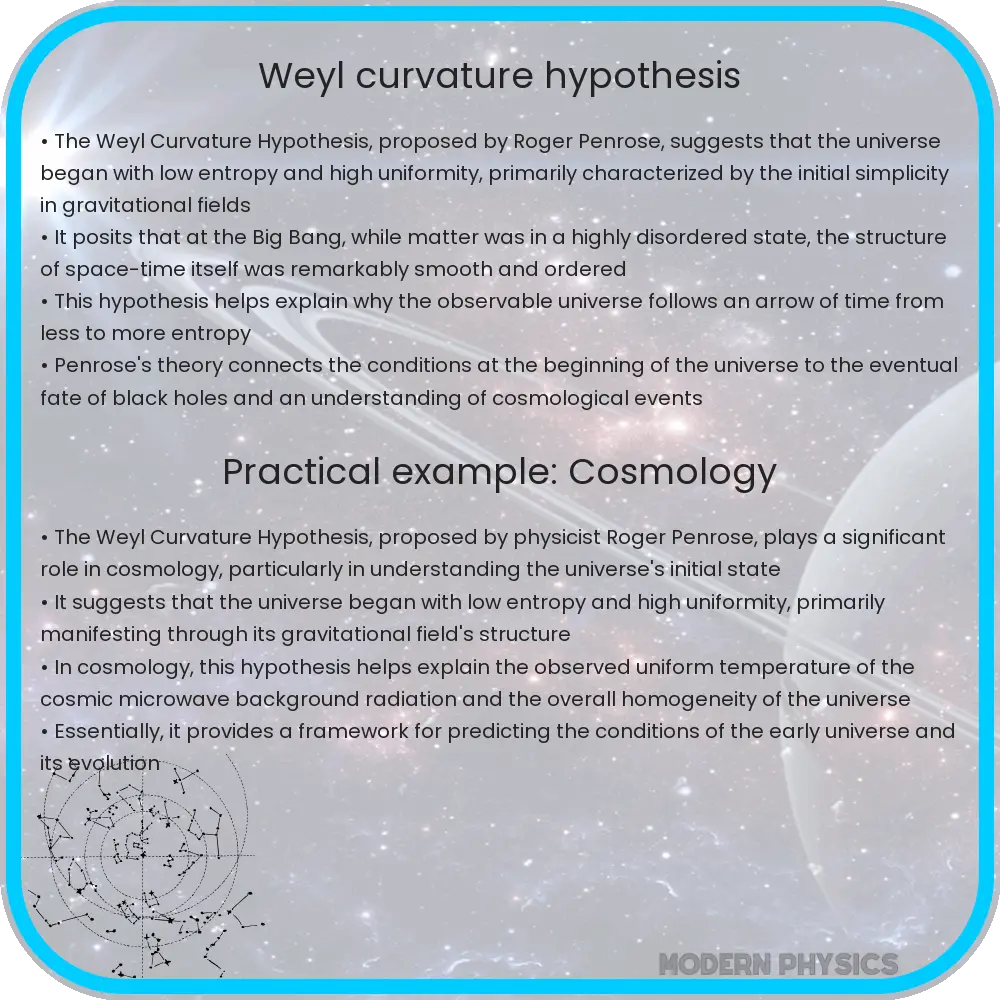Explore the Weyl Curvature Hypothesis, its origins, implications, and debates in cosmology, challenging our understanding of the universe’s beginning and structure.

Weyl Curvature Hypothesis: Unraveling the Origins of the Universe
The Weyl Curvature Hypothesis (WCH) is a fascinating concept proposed by Sir Roger Penrose, a prominent English mathematical physicist, in the latter part of the 20th century. This hypothesis suggests a profound connection between the geometry of the universe’s spacetime and the state of the universe at the time of the Big Bang. Specifically, Penrose hypothesized that the initial state of the universe had a very low Weyl curvature, which corresponds to a highly ordered, low-entropy condition.
Implications and Insights
The implications of the Weyl Curvature Hypothesis are vast and intriguing. In the realm of cosmology, it provides a potential explanation for the observed low entropy state at the universe’s inception, a condition essential for the Second Law of Thermodynamics and the arrow of time. According to Penrose, as the universe evolves, the Weyl curvature increases, leading to the growth of entropy and the manifestation of time’s arrow.
Furthermore, the WCH has significant implications for the theory of cosmic inflation and the ultimate fate of the universe. It challenges the conventional inflationary model, suggesting instead that the universe cycles through phases of expansion and contraction, known as “Conformal Cyclic Cosmology” (CCC). This cyclic view contrasts with the traditional singular Big Bang model and opens up new avenues for understanding the cosmos.
Debates and Discussions
Despite its compelling aspects, the Weyl Curvature Hypothesis is not without its critics. One of the main points of contention is the lack of direct observational evidence to support the hypothesis. Critics argue that the WCH, while elegant in theory, requires more empirical data to be considered a viable model of the universe’s origins and development.
Additionally, the hypothesis challenges established notions about the universe’s expansion and the nature of black holes, leading to heated debates within the scientific community. While some researchers find the hypothesis a valuable tool for rethinking cosmological models, others remain skeptical of its implications and viability without concrete proof.
Exploring the Mathematical Foundations
The mathematical underpinnings of the Weyl Curvature Hypothesis are deeply rooted in differential geometry and general relativity. Weyl curvature, part of the broader Riemann curvature tensor, encapsulates the tidal forces experienced by a body moving along a geodesic in spacetime. Penrose’s insight was to link this curvature to the universe’s entropy state at different epochs. By proposing that the Weyl tensor should be zero or negligible at the universe’s birth, he provided a geometric criterion for the Big Bang’s initial conditions, diverging from the standard singularity-dominated models.
Future Directions and Research
The ongoing debate and research into the Weyl Curvature Hypothesis underscore its significance in theoretical physics and cosmology. Future directions for research include looking for observational evidence to support or refute the CCC model, such as examining the cosmic microwave background radiation for patterns predicted by Penrose’s theory. Additionally, advancements in gravitational wave astronomy might offer new insights into the early universe’s dynamics, potentially providing the empirical data needed to validate or challenge the WCH.
Moreover, the hypothesis stimulates further questions regarding the nature of time, the structure of spacetime, and the ultimate fate of the universe. It encourages physicists to rethink the foundation of cosmological models and to explore new possibilities that bridge quantum mechanics and general relativity, two pillars of modern physics that remain fundamentally at odds.
Conclusion
The Weyl Curvature Hypothesis remains a groundbreaking yet contentious proposition in the quest to understand the universe’s origins and its ultimate fate. While it offers a novel approach to resolving some of cosmology’s deepest mysteries, such as the low-entropy state of the early universe and the nature of time, it also faces challenges in terms of empirical validation and acceptance within the scientific community. Nevertheless, the ongoing discourse around the WCH highlights the vibrant and dynamic nature of scientific inquiry, as researchers continue to probe the depths of the cosmos, challenging and refining our understanding of the universe’s most fundamental aspects. The hypothesis, regardless of its eventual validation, underscores the importance of theoretical diversity and innovation in the relentless pursuit of knowledge.
